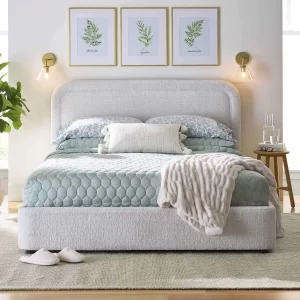Home automation is revolutionizing how we live, making our homes smarter, more efficient, and convenient. Imagine controlling your lights, security system, or even your coffee machine with a voice command or through an app on your phone. For beginners, the idea of automating your home may seem complicated, but it’s easier than you think. Let’s dive into what home automation is, how it works, and how you can start transforming your living space into a smart home.
What Is Home Automation?
Home automation refers to using technology to control and manage household devices and systems automatically. These can include lighting, heating and cooling, appliances, entertainment systems, security cameras, door locks, and more.
The beauty of home automation is that it allows you to set up rules or schedules so that certain tasks happen automatically without your intervention. For example, you can program your lights to turn off when you leave home or adjust the thermostat when you go to bed.
How Does Home Automation Work?
At its core, home automation systems are made up of three main components:
- Devices: These are the gadgets and appliances you want to automate, like lights, thermostats, cameras, and smart locks.
- Controllers: This can be a smartphone app, a voice assistant (like Alexa, Google Assistant), or a central hub that controls and manages your devices.
- Communication: Devices need a way to communicate with each other. This is usually done over Wi-Fi, Bluetooth, Zigbee, or Z-Wave networks.
Key Components of Home Automation
- Smart Lights
- Smart lights allow you to control the brightness, color, and on/off state of your lights from anywhere using a smartphone app or voice command.
- Popular Brands: Philips Hue, LIFX, TP-Link.
- Automation Ideas: Set schedules for when your lights turn on or off. You can even sync them with the sunrise or sunset or create different lighting moods for movie nights or parties.
- Smart Thermostats
- Smart thermostats let you control your home’s temperature remotely. They can learn your schedule and preferences, making your home more energy-efficient by adjusting the heating and cooling accordingly.
- Popular Brands: Nest, Ecobee, Honeywell.
- Automation Ideas: Program the thermostat to lower the temperature when you leave home and increase it before you return. This can save energy and lower your utility bills.
- Smart Plugs and Switches
- These devices make traditional appliances and lights smarter by allowing you to turn them on or off remotely.
- Popular Brands: TP-Link Kasa, Wemo, Meross.
- Automation Ideas: Plug your coffee maker into a smart plug to have it automatically start brewing in the morning. You can also use them for holiday lights or to control any non-smart device from your phone.
- Smart Security Systems
- Home security systems have evolved to include smart cameras, motion sensors, door/window sensors, and even video doorbells. You can monitor your home from anywhere and receive alerts if something unusual happens.
- Popular Brands: Ring, Arlo, SimpliSafe.
- Automation Ideas: Set your security system to arm automatically when you leave home or receive a notification when a door or window is opened unexpectedly.
- Smart Locks
- Smart locks offer keyless entry to your home, allowing you to lock or unlock doors with a smartphone app or voice command. You can also give temporary access to guests or service workers.
- Popular Brands: August, Schlage, Yale.
- Automation Ideas: Automatically lock your doors when you leave home and unlock them when you get back.
- Voice Assistants
- Voice assistants like Amazon Alexa, Google Assistant, and Apple Siri are central to home automation. They allow you to control various devices through voice commands.
- Popular Brands: Amazon Echo (Alexa), Google Nest (Google Assistant), Apple HomePod (Siri).
- Automation Ideas: Control your lights, thermostat, and music using voice commands, or set up routines like “Good Night,” where one command turns off all lights, locks the doors, and adjusts the thermostat.
- Smart Entertainment Systems
- You can automate your TV, speakers, and streaming devices to create an immersive entertainment experience.
- Popular Brands: Sonos, Google Chromecast, Roku.
- Automation Ideas: Create a movie-watching scene that dims the lights, turns on the TV, and plays surround sound with a single command.
- Smart Sensors
- Smart sensors detect things like motion, temperature, or water leaks. They can trigger actions, such as turning on a light when you enter a room or sending an alert if there’s a leak under the sink.
- Popular Brands: Aqara, Fibaro, Eve.
- Automation Ideas: Use motion sensors to automatically turn on lights when you enter a room or install a water leak sensor to receive an alert if there’s a leak in your home.
How to Start Automating Your Home
- Choose a Smart Ecosystem Before buying devices, choose a smart home ecosystem that fits your needs. Popular options include:
- Amazon Alexa: Compatible with a wide range of devices, Alexa offers flexibility and ease of use.
- Google Assistant: Google’s ecosystem is also compatible with many devices and is particularly strong in search-based tasks and commands.
- Apple HomeKit: If you’re an Apple user, HomeKit integrates seamlessly with iPhones, iPads, and Macs, offering strong security features.
Once you choose an ecosystem, make sure that the devices you buy are compatible with it.
- Start Small Don’t try to automate everything at once. Start with a few essential devices, like smart lights or a thermostat. These are easy to set up and provide immediate convenience. As you get more comfortable, you can expand by adding security features or entertainment systems.
- Use a Central Hub (Optional) While many smart devices can work independently, a smart hub like the Amazon Echo or Google Nest Hub can simplify managing multiple devices. Some hubs also support communication protocols like Zigbee or Z-Wave, which allow more devices to interact with each other.
- Create Automations and Routines Once you have your devices set up, you can start creating automations. These are rules that determine how your devices behave. For example:
- “Good Morning” Routine: Turn on lights, adjust the thermostat, and play music when you wake up.
- “Away from Home” Routine: Turn off all lights, arm the security system, and adjust the thermostat when you leave home.
- Integrate with Other Smart Devices As your smart home grows, you can integrate various devices to work together. For instance, your smart lights could flash when your doorbell rings, or your thermostat could adjust when your security system detects motion.
Benefits of Home Automation
- Convenience: Home automation makes life easier. You can control devices with a simple command or schedule them to operate automatically.
- Energy Efficiency: By automating lighting, heating, and cooling, you can significantly reduce energy consumption and save money on utility bills.
- Security: Smart locks, cameras, and sensors provide peace of mind, allowing you to monitor and control your home’s security remotely.
- Customization: You can tailor automations to your lifestyle, whether it’s creating the perfect atmosphere for movie nights or ensuring your home is secure when you’re away.
- Remote Control: Even when you’re not at home, you can control your smart devices through a smartphone app, ensuring everything runs smoothly.
Potential Challenges
- Compatibility: Not all smart devices work with every ecosystem. It’s important to check compatibility before purchasing new devices.
- Privacy Concerns: Some people are concerned about privacy, particularly with smart cameras and voice assistants. Make sure to choose devices from reputable brands with strong security features.
- Cost: While many smart devices are affordable, automating an entire home can add up. Start small and build over time.
Conclusion: Your Smart Home Journey Begins
Home automation might sound complex, but with the right approach, it’s an easy and rewarding way to make your life more comfortable and efficient. By starting with a few simple devices and gradually expanding your system, you can build a smart home tailored to your needs. Whether you’re looking to save energy, enhance security, or simply enjoy more convenience, the world of home automation is full of possibilities, waiting for you to explore.






